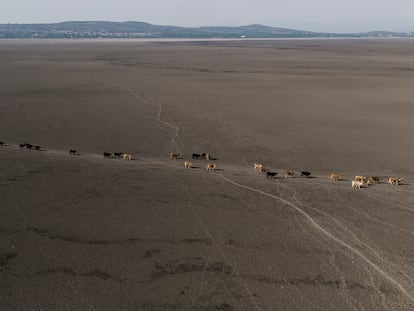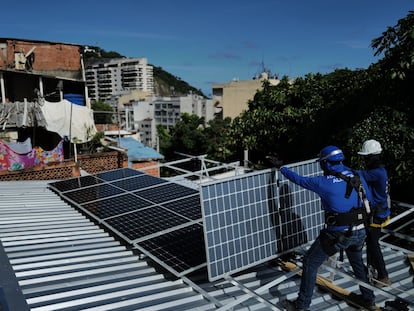Global study: Green transition is Latin America’s best weapon against informal labor and inequality
A new report released by OECD, ECLAC, CAF and the European Commission shows that private financing for development has tripled in the region, and identifies the care economy, agriculture and digital transformation as key sectors of opportunity

It’s no secret: talking about energy transition and digital transformation without the budgets to back it up is nothing but words and well-wishes. Or worse: smoke and mirrors. Latin America knows this all too well. The region is the most biodiverse in the world, and one of the lowest greenhouse-gas emitters, but continues to suffer some of the worse effects of climate change, exacerbated by the wide gap in inequality. Resources to adapt to the ravages of global warming are as urgently needed as they are scarce. In the past two decades, about 0.65% of the average Gross Domestic Product (GDP) for the region has been invested in research and development. This is significantly lower than the 2.7% average spending of the member countries of the Organization for Economic Cooperation and Development (OECD). According to a new report, Latin America Economic Outlook 2023: Investing in Sustainable Development, released this Friday in Santiago, Chile, 60% of these investments are managed by governments. This reflects a significant difference when compared to developed countries, where the greatest percentage of these investments come from the private sector.
“The companies that tend to invest in research and development are large companies, but in Latin America, small companies predominate,” explains Adriana Arreaza, Director of Macroeconomic Studies at CAF, the Development Bank of Latin America and the Caribbean. “And small companies are often informal, have little human capital and little access to credit markets, which keeps them from investing in research and development.”
The study was conducted and co-authored by four international organizations that maintain a strong presence in the region: OECD, the Economic Commission for Latin America and the Caribbean (ECLAC), the European Commission, and CAF. For the experts from these organizations, the way forward is clear. The region, they say, must focus on strengthening and improving investment in four main areas: digital transformation, health care, agriculture and food systems, and green transition.
According to José Manuel Salazar-Xirinachs, ECLAC’s Executive Secretary, while “digital transformation can contribute to improving productivity and competitiveness in the region, as well as being a way to take advantage of technological progress,” the health services and life sciences industries “can help increase resilience and preparedness for future health crises.” The care economy, he says, is another sector in major need of strengthening, both in terms of child care and elderly care, given that the population in need of these services is expected to grow to 150 million people by 2050. Salazar-Xirinachs also identifies agriculture as a key sector, given that “Latin America and the Caribbean have the largest reserves of arable soil in the world.”
Finally, the report identifies the green transition as a major opportunity for reducing the widespread informal labor conditions that reign across the region, which reached 48.7% in 2022. Green transition is a term that describes the move from hydrocarbon-based energy to renewables and an accompanying commitment to adopting environmental protection policies. The report emphasizes that this transition will require qualified personnel with advanced scientific knowledge and skills, which could contribute to the increased formalization of the economy. However, due to these same factors, green jobs are more likely to be assigned to men with higher levels of education, so the transformation must be combined with “policies to improve female employability.” In other words, the organizations assert, one of the current challenges is to ensure that women are fully included in the transition.
This, Arreaza adds, is another area where the care economy can once play an important role. “The provision of care services will allow more time for women to enter the labor market,” she says. “If care [whether for children or the elderly] does not fall exclusively on women, daughters or mothers, they will be able to participate more in the opportunities that the green economy will deliver.”
Foreign investment remains key for the region
The comprehensive report provides a valuable economic assessment of the different types of investment throughout the region, pointing out weaknesses and highlighting strategies that work. Foreign investment is one of the most celebrated areas. In 2022, for example, Latin America and the Caribbean had the highest inflows of foreign direct investment in the world, equivalent to 4% of the region’s GDP for that same year. “In 2022, inflows of this type of foreign investment increased by 55%, reaching nearly $225 billion, the highest level seen in the last three decades,” says Salazar-Xirinachs. This increase was specifically due to investments in services, hydrocarbons and manufacturing.
Likewise, Arreaza confirms that during the research process, the organizations that coauthored the report “found that foreign direct investment and foreign companies have higher productivity in all the countries of the region when compared to domestic companies. So, in that sense, foreign investment can have a pull effect for the rest of the productive apparatus” when it comes to providing clues about where to invest.
The analysis produced other interesting data. Over the past decade, for example, private financing focused on development in Latin America increased from $3 billion in 2016 to $9 billion in 2021. “International partnerships can also help yield greater socio‐economic impact of investments by creating an enabling environment for investment [and] fostering collaboration among institutions,” the report reads.
More than half of these inflows in 2022 went to Brazil and Mexico, while Central America experienced a decline of 11.9% that same year. In terms of origin, and based on project announcements, the European Union (EU) and the United States have accounted for more than half of these investments in the region.
Two strategies for boosting investment in innovation and development
While foreign investment has been key for Latin America and the Caribbean, the region needs more than just outside funding. To achieve a more ambitious scenario, the authors of the report emphasize that certain signals will need to be given at the level of public policy. “Advancing towards more effective and progressive tax systems, more efficient public spending and debt management, and stronger and more sustainable fiscal frameworks is essential to expand public investment in a context of limited fiscal space,” the report reads.
The study highlights two strategies to help improve the flow of public and private financial resources to achieve development goals. The first is the role of development finance institutions, which can help fund small and medium-sized businesses that have been unable, on average, to meet 75% of their financing needs. The second is to develop innovative financing instruments, such as “Green, Social, Sustainability and Sustainability‐linked (GSSS) bonds,” which currently account for 32% of the total international bonds issued in Latin America.
“The areas for innovation are very diverse,” concludes ECLAC’s Salazar-Xirinachs. “The interesting thing is to see how we can get the most out of the investments that can be made in each of these sectors, promoting productive linkages, demands for new skills, the creation of new companies and the development of new financing and participation instruments.”
Sign up for our weekly newsletter to get more English-language news coverage from EL PAÍS USA Edition
Tu suscripción se está usando en otro dispositivo
¿Quieres añadir otro usuario a tu suscripción?
Si continúas leyendo en este dispositivo, no se podrá leer en el otro.
FlechaTu suscripción se está usando en otro dispositivo y solo puedes acceder a EL PAÍS desde un dispositivo a la vez.
Si quieres compartir tu cuenta, cambia tu suscripción a la modalidad Premium, así podrás añadir otro usuario. Cada uno accederá con su propia cuenta de email, lo que os permitirá personalizar vuestra experiencia en EL PAÍS.
¿Tienes una suscripción de empresa? Accede aquí para contratar más cuentas.
En el caso de no saber quién está usando tu cuenta, te recomendamos cambiar tu contraseña aquí.
Si decides continuar compartiendo tu cuenta, este mensaje se mostrará en tu dispositivo y en el de la otra persona que está usando tu cuenta de forma indefinida, afectando a tu experiencia de lectura. Puedes consultar aquí los términos y condiciones de la suscripción digital.
More information
Archived In
Últimas noticias
There is as much life left to discover on planet Earth as that which is already known
Dozens presumed dead, around 100 injured in fire at Swiss Alps bar during New Year’s celebration
Is porn for women different from conventional porn? We spoke to those who make it
Cartagena de Indias is sinking: What can the city do to mitigate it?
Most viewed
- David King, chemist: ‘There are scientists studying how to cool the planet; nobody should stop these experiments from happening’
- Reinhard Genzel, Nobel laureate in physics: ‘One-minute videos will never give you the truth’
- Oona Chaplin: ‘I told James Cameron that I was living in a treehouse and starting a permaculture project with a friend’
- Sinaloa Cartel war is taking its toll on Los Chapitos
- The Interoceanic Train, the Mexican alternative to the Panama Canal










































